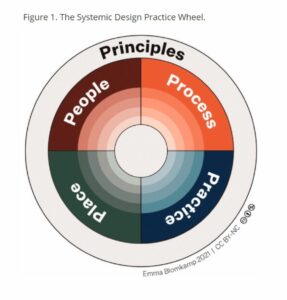
Governments around the world are adopting the principles and tools of systems thinking, human-centred design and co-design. A paper in Policy Design and Practice offers both a case study and practice framework to bridge the gaps in the theory and practice of systemic design and participatory policymaking.
What is systemic design?
Policy makers are using different methods to engage a wide range of stakeholders and citizens in policy development and implementation. Alongside design and systems thinking, systemic design has emerged as a practice that integrates dialogue, design and co-creation for sensemaking and decisionmaking.
Systemic design is an approach to participatory policymaking that involves:
- creating the conditions for stakeholders to more meaningfully participate in building shared knowledge and taking collective action.
Related briefs:
- The promise of co-design for public policy
- Designing digital services for better user experience
- When the public deliberates on policy design
A case study approach
The article presents a framework to understand systemic design in the public sector using a case study of community services policymaking in Aotearoa-New Zealand.
This policy project was led by a government organisation to address its lack of consistency in providing and supporting community facilities. The project resulted in a policy framework designed to guide strategic and operational decisionmaking. It also improved organisational practice in community relationships and facility management. A key feature was its experimental design-led methodology.
The research involved:
- 17 semi-structured interviews including the lead policy designer, project sponsor, project team members and external consultants
- observing meetings involving the policy designer and external service providers.
A systemic design practice framework
The Systemic Design Practice Wheel has five core domains (see Figure 1):
- Principles: Why and how does this work need to happen? What matters most?
- Place: Where does this work sit and fit? Which level are we working at?
- Process: Who needs to be involved? What resources and support do they need?
- People: How will we structure and organise our approach?
- Practice: What specific methods, techniques and tools will enable us to reach our objectives and follow our principles?
Core principles
The 5 Ps framework has six core principles.
1. Purpose-driven
Like other forms of design and innovation, systemic design aims to produce a particular result or change. By identifying an ideal state, participants in systemic design articulate a common goal and are motivated to act together to achieve a desirable outcome.
2. Recognising complexity.
Systemic design is founded on the recognition of complex adaptive systems. These have features such as self-organisation, feedback loops and emergence. Complexity requires us to work together to build understanding of the system(s) we are seeking to influence and to remain open to reframing problems and boundaries as new understandings emerge.
3. Self-determination
Taking a rights-based or strengths-based approach is a value of ethical systemic design practitioners. Applied to individuals in co-design, this is often expressed as, “people are the experts in their own lives” or “experts of their experience”.
4. Equalising power
Systemic design aims to reconcile power relations between individuals and organisations by eliciting and incorporating a variety of perspectives. There are two main dimensions to this principle:
- equality of voice is actively promoted through creating the conditions for genuine participation. This entails a shift in the role of the lead designer or policy practitioner from “expert” to “enabler”.
- leadership is distributed and decisionmaking devolved as much as possible.
5. Inclusive collaboration
Systemic design engages diverse worldviews, leverages the expertise of each participant, and enables stakeholder collaboration to create implementable plans and ethical action. The selection of participants should take into account the different kinds of knowledge they hold, including lived, professional and specialist expertise.
6. Adaptive learning.
Systemic design requires the creation of space, mindsets and mechanisms for collaborative problem-solving and mutual learning. Continuous feedback and a flexible accountability structure are needed to enable ongoing adaptation throughout the design process, from the early phases of problem framing through development to implementation.
The bottom line
The design-led approach of the case study project had benefits for policymaking by:
- building a human-centred understanding of issues and systems
- involving a range of people in innovative and engaging ways.
The experience of taking part in the project encouraged staff to be in a state of readiness for change. They saw the value in not starting with predetermined problems and were keen to experiment with different methods.
However, there was not consistently strong understanding or support throughout the organisation, especially by senior managers. It was at times challenging for the organisation to provide the requisite skills and expertise for systemic design or to adapt to different ways of working.
Participants also noted that the collaborative approach to building relationships and understanding demanded more time than usually required by staff in the early phases of policy development.
Despite the challenge and cost of participatory approaches, systemic design may nevertheless pay off in the longer run by establishing solutions that enjoy a higher degree of endorsement and robustness.
Want to read more?
Systemic design practice for participatory policymaking – Emma Blomkamp, Policy Design and Practice, February 2021
Each fortnight The Bridge summarises a recent piece of academic research of relevance to public sector managers.
Recent Research Briefs include:
- Published Date: 23 March 2021

